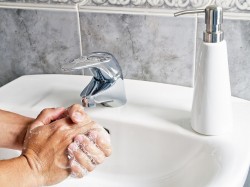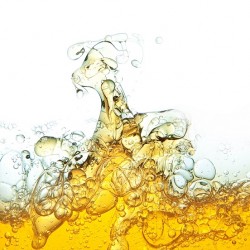Surprisingly, soap may not be our best cleanser; for thousands of years, Ayurvedic oil massage techniques have been used to cleanse the skin.
The Somewhat Gross Origin of Soap
The first use of soap was recorded in ancient Rome, where animal fats from ritual sacrifices floated downstream in the rivers. The mixing of the fat with water created suds. The story goes that women washing clothes in the river discovered that these suds were unparalleled for washing clothes (1). Over time, animal and vegetable fats were mixed with ash and other substances to create traditional soaps. Today, we know that when you mix vegetable oils with water they create a saponification, or soap effect (6, 7, 8).
Soaps today have come a long way from such a pure mixture of water and fat, and most soaps now contain fillers, synthetic saponification agents, emulsifiers, and fragrances.
On top of being potentially toxic (in the case of soaps laden with chemical fragrances and fillers), soaps can compromise skin by breaking down its delicate ecosystem. The vast majority of Westerners have scrubbed their skin so clean with soap that many of the natural oils have been washed away, leaving most folks in desperate need of a moisturizer. Sadly, few moisturizers actually moisturize; mostly, they hydrate or sometimes plump up the surface layers of the skin without deeply moisturizing or helping the skin actually function.
Keep reading to learn an effective alternative for washing with soap that has been used to nourish the skin for thousands of years!
Soaps May Actually Cause Even More Harm
Microbes thrive on the skin that lines both the inside and outside surfaces of the body. The outer skin produces an oil called sebum. The sebum softens, lubricates, and protects the skin. It also prevents the skin from drying out and aging prematurely.
Perhaps most importantly—and quite possibly the mechanism by which it does all these other things—it feeds the beneficial bacteria that live on the surface of the outer skin and produces immune-boosting fatty acids which create the skin’s protective, self-cleansing barrier (2).
Most soaps remove these necessary fats on the skin, compromising the skin’s natural glow, its immunity, and killing all those good bugs that do the heavy lifting for many of the body’s functions.
Back to Soap Basics
As we’ve learned, the actual basis of soap is a mixture of fat—or oil—and water. Going back to this simple technique of mixing oil and water to create a cleansing soap is backed by some compelling research, which suggests that high-quality vegetable oils will actually feed the beneficial bacteria on the surface of the skin much in the same way as the skin’s natural sebum does (2). In addition, Ayurvedic oils, which are vegetable oils infused with herbs, have a similarly deep moisturizing effect on the skin as the sebum—the skin’s natural oil.
Oil Pulling on the Skin
Swishing or gargling in the mouth with oil—traditionally called oil pulling—has been shown to have a saponification (detergent or cleansing) effect on the oral mucosa (8). The same technique supports a healthy immune response against foreign microbes and plaque in the mouth by supporting the health of the beneficial microbes that produce immune-boosting fatty acids (7, 6).
This suggests that oil plus water equals suds. Not just any suds, but suds that are effective at killing bad bugs.
In addition, oil pulling is a technique made famous for the pulling effect oils have on toxins in the body. While I was unable to find reliable research on the systemic health benefits of oil pulling, there is Ayurvedic research that shows that oils do pull toxins out of the body when ingested and massaged into the skin during a detox process called Panchakarma (9, 10). This effect is the hallmark of Ayurvedic cleansing and all of the cleanses I have designed at LifeSpa.
Ghee has been ingested as a part of cleanses for thousands of years for its lipophilic effect (having an affinity for or the act of combining with lipids) on other fat-soluble toxins in the body. This means that when you ingest the ghee along with a special cleansing diet, the ghee will pull other fat-soluble or lipophilic toxins from the body. This effect has been measured, and has shown to pull 14 known fat-soluble heavy metals and toxins out of the body for 3 months after the ghee therapy was concluded (8, 9, 10).
In these same studies, daily oil massage was administered. Oil massage, according to Ayurveda, has the same lipophilic pulling or detoxifying effect only this time on the surface of the skin (8, 9, 10). Applying oil to the skin has been used for thousands of years to create such a pulling, scrubbing and detoxifying effect on the skin.
 A Summary of Oil Cleansing Benefits
A Summary of Oil Cleansing Benefits
- Ayurvedic herbalized oils moisturize the deeper layers of the skin, while soaps dry the skin out.
- Oils feed the good microbes on the skin—supporting the function of the skin—while soap destroys the environment for good bugs.
- Oils have a saponification or detergent effect on the skin without destroying the good microbiology of the skin.
- Oils on the skin have a pulling or detoxifying effect on the skin.
- Oils on the skin support a healthy immune response against foreign microbes by supporting the health of the beneficial microbes that produce immune-boosting fatty acids.
Consider minimizing the use of soaps and maximizing the use of oil on your skin daily as both a cleanser and moisturizer in one.
Do it in the shower or bath, so the oil and water can mix and create the magic.
Here is my favorite daily oil cleansing technique:
1. As soon as you enter a hot shower or bath, apply an herbalized oil and massage deeply into the skin. Learn how to do an Ayurvedic self-massage technique called Abhyanga here.
2. Once the oil is rubbed, continue with shampoo, conditioning etc…use minimal soap, if any!
3. When ready to get out of the shower, take a wet wash cloth and rub the oil off your skin. The applied oil will “pull” impurities out of the skin, so it is important to take this oil off.
4. Finally, before leaving the shower, apply a fresh thin coat of oil all over the body.
Note: When you use the oil in the shower, the water will naturally and evenly spread a very small amount of oil all over the body and wash off any excess. The result we are going for is moisturized, but not greasy.
Click here for LifeSpa Oil Cleansing Therapy Options: “Beauty Secret for Healthy Skin”
Sources:
2. The Skin Microbiome. Nat Rev Microbiol. 2011 April;9(4):244-53
3. Seminars in Immunopathology, April 2007, Volume 29, Issue 1, pp 3-14
The skin barrier as an innate immune element. Peter M. Elias
4. An analysis of sebum excretion rate, bacterial population and the production rate of free fatty acids on human skin, J. H. COVE1, K. T. HOLLAND1, W. J. CUNLIFFE2. Article first published online: 29 JUL 2006. DOI: 10.1111/j.1365-2133.1980.tb07260.x
5. Healing fats of the skin: the structural and immunologic roles of the ω-6 and ω-3 fatty acids. Clinics in Dermatology, Volume 28, Issue 4, Pages 440-451. Meagen M. McCusker, Jane M. Grant-Kels
6. Asokan S, Emmadi P, Chamundeswari R. Effect of oil pulling on plaque induced gingivitis: A randomized, controlled, triple-blind study. Indian J Dent Res. 2009; 20:47–51. [PubMed: 19336860]
7. Effect of oil pulling on Streptococcus mutans count in plaque and saliva using Dentocult SM Strip mutans test: a randomized, controlled, triple-blind study. J Indian Soc Pedod Prev Dent. 2008 Mar;26(1):12-7. PMID: 18408265
8. Indian J Dent Res. 2011 Jan-Feb;22(1):34-7. doi: 10.4103/0970-9290.79971. PMID: 21525674
9. Sharma HM, Midich SI, Sands D, Smith DE: Improvement in cardiovascular risk factors through Panchakarma purification procedures. J Res Educ Indian Med, 1993; 12(4); 2-13.
10. Heron, Fagan. Alternative Therapies in Health and Medicine in its September/October 2002 issue, two
Love elephant and want to go steady?
Sign up for our (curated) daily and weekly newsletters!
Editor: Jenna Penielle Lyons
Photo: Main image from elephant journal archives; smaller images courtesy of author











Read 0 comments and reply